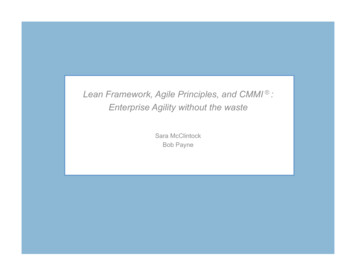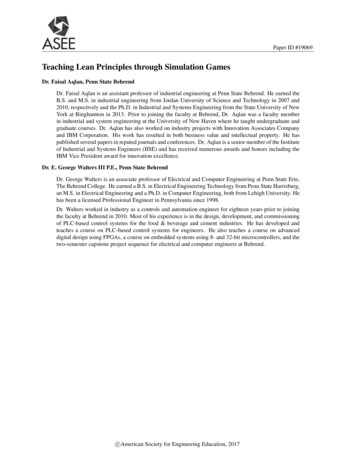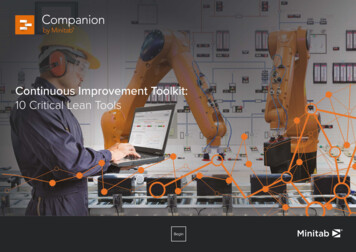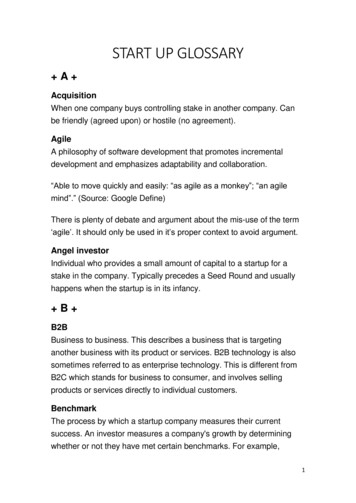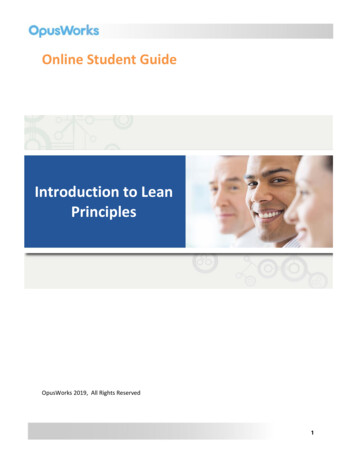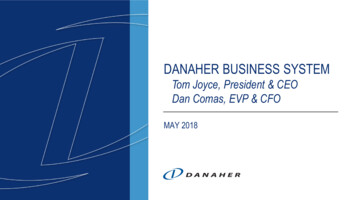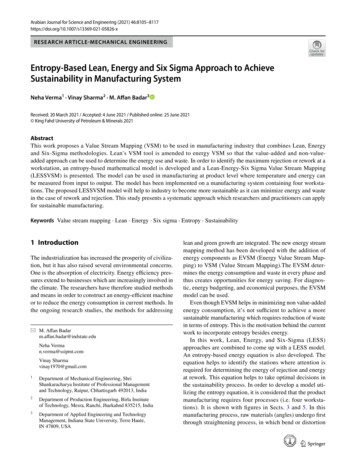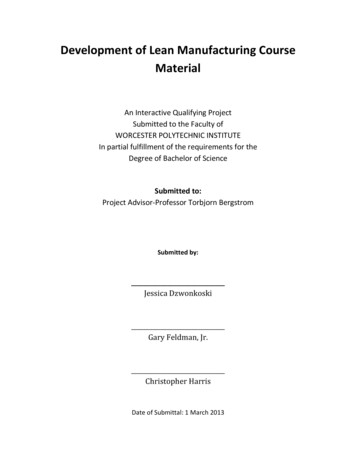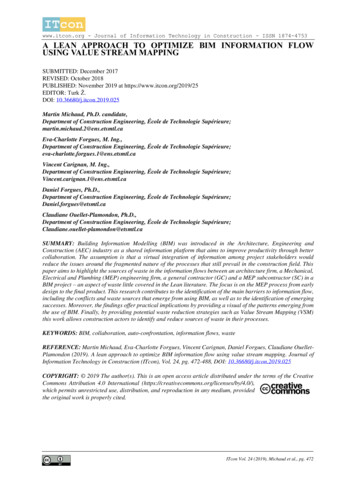
Transcription
www.itcon.org - Journal of Information Technology in Construction - ISSN 1874-4753A LEAN APPROACH TO OPTIMIZE BIM INFORMATION FLOWUSING VALUE STREAM MAPPINGSUBMITTED: December 2017REVISED: October 2018PUBLISHED: November 2019 at https://www.itcon.org/2019/25EDITOR: Turk Ž.DOI: 10.36680/j.itcon.2019.025Martin Michaud, Ph.D. candidate,Department of Construction Engineering, École de Technologie lotte Forgues, M. Ing.,Department of Construction Engineering, École de Technologie incent Carignan, M. Ing.,Department of Construction Engineering, École de Technologie Supérieure;Vincent.carignan.1@ens.etsmtl.caDaniel Forgues, Ph.D.,Department of Construction Engineering, École de Technologie Supérieure;Daniel.forgues@etsmtl.caClaudiane Ouellet-Plamondon, Ph.D.,Department of Construction Engineering, École de Technologie UMMARY: Building Information Modelling (BIM) was introduced in the Architecture, Engineering andConstruction (AEC) industry as a shared information platform that aims to improve productivity through bettercollaboration. The assumption is that a virtual integration of information among project stakeholders wouldreduce the issues around the fragmented nature of the processes that still prevail in the construction field. Thispaper aims to highlight the sources of waste in the information flows between an architecture firm, a Mechanical,Electrical and Plumbing (MEP) engineering firm, a general contractor (GC) and a MEP subcontractor (SC) in aBIM project – an aspect of waste little covered in the Lean literature. The focus is on the MEP process from earlydesign to the final product. This research contributes to the identification of the main barriers to information flow,including the conflicts and waste sources that emerge from using BIM, as well as to the identification of emergingsuccesses. Moreover, the findings offer practical implications by providing a visual of the patterns emerging fromthe use of BIM. Finally, by providing potential waste reduction strategies such as Value Stream Mapping (VSM)this work allows construction actors to identify and reduce sources of waste in their processes.KEYWORDS: BIM, collaboration, auto-confrontation, information flows, wasteREFERENCE: Martin Michaud, Eva-Charlotte Forgues, Vincent Carignan, Daniel Forgues, Claudiane OuelletPlamondon (2019). A lean approach to optimize BIM information flow using value stream mapping. Journal ofInformation Technology in Construction (ITcon), Vol. 24, pg. 472-488, DOI: 10.36680/j.itcon.2019.025COPYRIGHT: 2019 The author(s). This is an open access article distributed under the terms of the CreativeCommons Attribution 4.0 International ch permits unrestricted use, distribution, and reproduction in any medium, providedthe original work is properly cited.ITcon Vol. 24 (2019), Michaud et al., pg. 472
1.INTRODUCTIONThe traditional vision of construction management focuses on the division of a project into lots and activities,while BIM projects focus on an information-centric management. Winch (2009) explained that the goal ofconstruction management is to ensure that the process of producing the information describing the deliverablescorresponds to what is expected by the client. The problem is the information gaps between the different phasesof a project. Indeed, the product is not even defined at the beginning of a project. BIM presents a viable solutionto this problem, as it aims to facilitate the exchange of building information by implementing a centralized platformdesigned to ease information sharing. However, the inherent difficulty in transferring information properly andaccurately between the actors throughout the phases of a project limits the advantages of BIM (Coates et al. 2010).The BIM benefits expected in a project are an improved coordination and collaboration, an optimization ofscheduling and costs, reduced drafting time with no loss of quality or any increased cost, improved conflictdetection and risk mitigation, a high level of customization and flexibility and streamlined building life cyclemanagement. BIM implementation requires an adaptation of the involved parties due to process changes (Volk,Stengel, and Schultmann 2014). Indeed, a successful deployment of BIM requires a review of the way things aredone with a transition from a document-centric approach (traditional) to an information-centric approach. BIMcan be seen as the reengineering concept founded and developed by Hammer and Champy (1993) and defined as:“the fundamental rethink and radical redesign of business processes to generate dramatic improvements in criticalperformance measures – such as cost, quality, service and speed.” This concept promotes a process-centredorganization to provide significant gains in performance.The value of BIM is often described as providing processes and tools to streamline the production and exchangeof information through a unique and shared platform (Eastman et al. 2011); enabling all stakeholders to share thesame set of data, thereby avoiding all the issues of information loss, alterations or overproduction (Crotty 2013).BIM is used as a platform for data management either for the architect, the owner or any other actor in the processto retrieve or display information in a consistent format (Goedert and Meadati 2008). Information processing playsa major role in construction projects as it includes all the communication, exchange, collection, processing anddistribution of information (Zhang, Liu, and Chan 2018). Several issues have been identified, such as the lack oftrust and coordination between the actors of the supply chain, problems with integration in the supply chain, andthe difficulties inherent in breaking traditional work patterns. There is currently a lack of research on this subjectin the literature.This paper explores the information processing issues in a BIM project between firms, with a focus on theMechanical, Electrical and Plumbing (MEP) process of a Private-Public Partnership (PPP) project. The higheststakes regarding the information process are observed within the MEP process, as it is the last process in the designchain and it provides information concerning a building’s operation and maintenance. During a PPP project, thecollaboration between professionals and SCs is eased because all stakeholders are engaged early in the projectwith only one contract linking all the team members. The aim of the research is to identify conflicting andsuccessful areas in the BIM using an empirical approach through the collaborative mapping of stakeholder’sindividual perceptions. Process maps were produced and compared to highlight what must be improved regardingBIM information processing. This paper offers an observatory study designed to provide significant insight intothe current situation in the construction industry. A diagnosis of the current problems is provided in order to findsolutions. The main novelty of the paper is its approach that allows the visualization of the information flows inBIM construction projects. This visualization approach provides a tool to better understand the processes and helpsto identify the sources of waste within information flows.After this introduction, this article contains five more sections. A literature review focusing on BIM and its impacton construction processes is followed by a description of the methodology used for the research and a descriptionof the case study. The subsequent section gives an analysis of the results gathered from the case study. A discussionsection then provides potential solutions to the problems identified during the study. Finally, the last sectionsummarizes the paper’s contributions and limitations and presents the conclusions along with somerecommendations for future work.ITcon Vol. 24 (2019), Michaud et al., pg. 473
2.THE BIM APPROACH AND THE NOTION OF FLOW2.1BIM and its impact on construction processesFour major elements defining the BIM rhetoric have been identified (Miettinen and Paavola 2014): (1) the use ofBIM models to regroup all relevant data; (2) a new integrated way of working driven by the need for bettercollaboration around a shared platform and interoperability between systems; (3) the use of BIM throughout theentire lifecycle of a building; and (4) an increase in productivity and efficiency. However, these elements are partof an idealistic BIM view, as several constraints act as barriers to a proper BIM implementation, i.e. the fragmentednature of the construction industry, particularly in the field, rivalry between partners in a project or the presenceof disruptions in construction projects. Each of the four elements mentioned by Miettinen and Paavola (2014) canbe integrated into the study of construction processes. This section offers a comprehensive literature analysis in anattempt to determine the elements that are preventing BIM from being implemented in the construction field.Firstly, transferring models into a centralized platform will facilitate information sharing. Having a centralizedplatform containing all the information of the different stakeholders helps to highlight the incompatibilitiesbetween the systems and to facilitate coordination while providing a common 3D vision of the project to all thestakeholders (Deutsch 2011). The full potential of BIM benefits can only be realized if a common platform isshared among all stakeholders, including the supply chain (Taylor and Bernstein 2009).Secondly, a new collaborative way of working will allow to maximize BIM benefits. The traditional way ofproducing and exchanging information is through documents that are “pushed” as deliverables from phase to phaseto the next actors in the process (Kiviniemi 2011). In contrast, BIM’s information-centric approach supports theprocesses of a project by providing pre- and post-conditions to each activity to limit waste and allow more informeddecisions. In a non-lean organization, the work is pushed through the system, whereas in a lean system, actors pullthe work, making the system react to the client’s demands. For example, in a traditional push system, the architectproduces a model and transmits it to the engineer, who creates the next model according to the informationprovided by the architect. This process goes on until it reaches the sub-contractor responsible for the construction.In a pull system, the architect asks the engineer for the information required to produce an accurate model. Thisprocess is repeated with each actor of the process to limit sources of waste, such as rework due to lack ofinformation or overproduction of information.Thirdly, the use of BIM throughout the entire lifecycle of a building forces the early phases to be planned so as tolimit problems during the construction and operation and maintenance phases. With the implementation of BIMand the acknowledgement of the importance of information flows in the construction industry, these processes arenow studied to identify sources of waste, such as overproduction of information or problems in informationtransfer. However, an important aspect rarely considered in the construction industry regarding the reduction ofwaste is to tackle it from the source. Indeed, up to 33% of waste originates from design (Innes 2004). Thus, theidentification and reduction of sources of waste must be done during the design phase of a construction project.Early actions will help reduce the amount of waste throughout a construction project (Osmani, Price, and Glass2005). However, these studies focus only on materials and/or work flows and do not consider information flowsas a potential source of waste.Fourthly, greater efficiency and higher productivity can be achieved by the standardization and propermanagement of information flows. Turk (2000) investigated the concept of flow in detail. He proposed a modelintegrating the workflow, the material flow and the information flow that clearly shows how these flows areinterrelated. The main problem resulting from not managing these interactions is that when there is a problem inone flow, it affects the other flows’ waste. For example, the production of incorrect information will impact thematerial flow, as it will cause the wrong equipment or material to be ordered, leading the workflow to lose timewaiting for the correct equipment/material to be ordered and delivered.This review has identified four distinct ways in which BIM can impact construction projects: (1) by replacingtraditional construction processes with the transfer of models into a centralized platform; (2) by employing a newcollaborative way of working; (3) by incorporating lifecycle management into the construction supply chain; and(4) by the standardization and proper management of information flows. These four elements show the importanceof information flows in the implementation of BIM.The concept of flow is an inherent part of lean thinking. One concept of lean manufacturing is that production isviewed as a flow that describes how information and material are being processed (Koskela 2000). Anydiscrepancy in the flow creates problems, also called wastes, which can impact the information, work or materialITcon Vol. 24 (2019), Michaud et al., pg. 474
flows. To improve these flows in construction projects, the sources of waste must be identified. To date, wastewithin information flows in construction remains a subject that is not well-documented.2.2The notion of flow and the importance of information flowGarcia Lopez (2017) describes information flows as support flows and explains their importance in construction.As a part of developing the Transformation-Flow-Value generation (TFV) theory, (Koskela 2000) states that themost important principle is to reduce variability; in other words, to increase standardization. Over the past severalyears, a number of studies have been conducted to increase standardization in construction (Martinez et al. 2015;Aapaoja and Haapasalo 2014; Yu et al. 2009).Many models have been developed to manage information flows with the goal of reducing waste. Otjacques, Post,and Feltz (2003) proposed a proof-of-concept tool designed to help manage information flows during constructionprojects by mixing push and pull functionalities. Their tool provides solutions to information managementproblems such as information overload, retrieval or asymmetry, all of which are sources of waste withininformation flows. However, the research scope is limited to the construction phase, with no accounting of thewaste generated by flaws in the design process.Tribelsky and Sacks (2010) measured information flows in the design process through data collected from severalconstruction projects. The data they gathered was transacted through a web server which allowed their research toaccess quantifiable data. They identified seven numerical indices (action rate, package size, work in process, batchsize, development velocity, bottlenecks and rework) with which to measure information flows and to detect thepresence of waste. However, while this research allowed quantitative data on sources of waste to be collected, itdid not address the need to collect qualitative data, such as data on issues of coordination, information transfer oron the over-production of information due to misunderstandings about the process.To facilitate information management, the quality and reliability of the information created must be quite high.Zadeh, Staub-French, and Pottinger (2015) reviewed four types of information quality issues: informationincompleteness, value inaccuracy, spatial inaccuracy and model incompatibility. Garcia Lopez and Fischer (2016)studied flows such as information flows between activities during the construction phase. They collected data tohelp managers cope with workflow variability in the field. While variability has been identified as a source ofproblems in construction, no other source of waste was identified during this research.These problems observed in BIM construction projects are responsible for several sources of waste in theinformation management process, including rework due to inaccurate or incomplete information or overproductionof information due to the generation of unnecessary information. Standardization must be in the foundation of animproved information flow. Mirarchi et al. (2017) recently proposed a method to improve the information flow inconstruction by increasing standardization using automated IFC-based processes. Their aim was to improveinteroperability within BIM environments. While their results offer positive outcomes, their paper’s focus waslimited to the sharing and exchange of information. In contrast, the approach used in this article aims to identifyadditional sources of problems and to propose potential solutions for each.Compared to the Architecture, Engineering and Construction (AEC) industry, research on information flows inother industries is much more advanced and can provide important insights on how to improve information flowsin construction projects. Cetin and List (2002) proposed a new approach for integrating the information flow andthe physical flow in transportation networks. Their approach focuses on the interaction between flows; to providea better transportation system, both flows should be expressed in the same model to determine the impact of wastein the information flow. Attempts to reduce waste in workflows and in material flows without including theinformation flows cannot give optimal results due to the interrelation between these flows. As another example,Wang et al. (2010) have devised a method that allows the management and control of information processing inthe supply chain process in the military industry.BIM has been introduced in the construction industry to improve interoperability and collaboration among theparties involved in construction projects (Eadie et al. 2014). However, several issues can be observed with BIMcollaboration, such as the quality and quantity of information exchanged between the involved parties, theresistance to change, the lack of understanding of the entire information flows process and the lack of commonshared vision (Forgues et al. 2016). These issues tend to keep the actors from the same project or even the sameprocess apart, thus facilitating the creation of waste within the information flows. However, recent research hasshown that there is a desire to reduce waste in construction processes with the help of BIM. Ahankoob et al. (2012)studied the potential impact that BIM can have on reducing waste in the design phase by focusing on the materialsITcon Vol. 24 (2019), Michaud et al., pg. 475
flow, and Porwal (2013) focused on addressing the methods of waste management at the source while using BIM.Both studies show the potential of BIM in construction and its role in the identification and reduction of waste inBIM processes. However, as seen earlier, while BIM was developed to improve collaboration and informationflows, none of these studies have addressed waste in information processing.Many underlying factors can affect the results from one project to another. For example, the contract type (Mooreand Dainty 2001), or the quality of the project participants as well as their BIM maturity (Kassem and Succar2017). The contract defining the project delivery impacts the team integration and group cohesion (Franz et al.2016). For example, with a design-build delivery, all actors join the project during the design phase, changing theirrelationships. With a traditional delivery, subcontractors are brought into a project much later, leading to a lowerlevel of communication and coordination. Franz et al. identified five classes of project delivery methods andobserved that high cohesion and team integration led to positive effects, such as lower costs or higher client ratingsfor building system quality. However, they did not consider the maturity level of the actors participating in aproject. In a BIM project, players do not have the same experience with BIM, impacting the results on the project.As more and more actors are using BIM in their projects, their BIM integration maturity is developing; this ongoingprocess will solve some problems such as the organization of work issues or semantic gap (Smits, van Buiten, andHartmann 2017).This review has identified several studies focused on information flows, but much work remains to bring theconstruction field up to the level of other industries. Of particular interest is the need to manage flow and add valuethrough better information processing. This paper provides a way to fill the gap identified in this review: the lackof knowledge during the design phase of construction projects, specifically the lack of qualitative data on sourcesof waste in information flows.3.METHODOLOGYThis paper presents the results, obtained via an investigation, of a case study of a 265.7 M (CAD) jail replacementconstruction project, a public private partnership (PPP). Due to the increased complexity created by the duplicationof all the technical systems required by the security requirements, the general contractor (GC) decided to invitesubcontractors (SC) to participate from the design phase to the end of the project, and to use BIM to help reducedesign errors and ease collaboration and communication throughout the entire project. Considering these factors,this exploratory research provides data for a PPP project using a design-build delivery with stakeholders that havea range of maturity levels in the use of BIM. The mechanical, electrical and plumbing (MEP) process is the mostcomplex process to coordinate (Wang and Leiti 2016). The research therefore focused on the MEP processcoordination.This study used an investigative method based upon a case study research approach (Yin 1994; Hancock andAlgozzine 2016; Fellows and Liu 2015). The data was collected from October 2015 to February 2016 through twointerviews (each one and a half hour long) with each participant. The auto-confrontation technique was used duringthe interviews and was part of the data collection process (Forgues et al. 2016). These interviews occurred at theend of the construction project when the processes were over, and the participants could easily remember whathad been done during the various phases of the project. The participants were the project managers of thearchitecture firm and of the MEP engineering firm, the MEP contractor and the MEP BIM coordinator from theGC. At the end of the construction project, the research protocol was specifically designed to help the participantsmap the information flow between the parties involved in the MEP process. To obtain accurate and consistentresults among the participants, the mapping has been adapted based on the standard graphic of the Business ProcessModel and Notation (BPMN). BPMN allows actors to create a graphical representation for specific processes in aprocess model by using a small number of elements in simple diagrams (Scherer and Ismail 2011) (see table 1).The five main elements are easy to manipulate for process modelling by an unexperienced participant. BPMN’sfive main elements were used to simplify the mapping and to gather the necessary information about thecommunication workflow between the various stakeholders, as listed in Table 1.The data gathering for the process modelling focuses on three important aspects: The workflow between the different actors; The input and output of information for each activity; and The representation of this information in material objects or documents.To study interoperability and the number of models in the flows, a new aspect was proposed to support the process: A technological tool: The format and software used to transfer the documents and information.ITcon Vol. 24 (2019), Michaud et al., pg. 476
Table 1. Elements present in the BPMN mappingElementBPMN - IconBeginningEndActivityDocument / InformationDecisionThe auto-confrontation technique used here is a method developed in cognitive science to confront the participantwith their own reality (Clot et al. 2000). This technique was used by Forgues et al. (2016) to demonstrate maturityissues with BIM. In that study, the participants and the researchers co-constructed maps between the lifecycle ofa construction project and the stakeholders (Forgues et al. 2016). The mapping allows the research collaboratorsto obtain data highlighting the different points of view of the various actors of a single process, thus pinpointingthe issues and reasons for the presence of barriers between the stakeholders and the sources of hindrances tocollaboration.The method was adapted for the identification of the sources of waste by reusing the data collected in this empiricalvalidation. The flows were revised to isolate the good and bad practices that are often mentioned in the literature,as well as to validate the existing theories and observations on issues in these practices. After using the autoconfrontation technique to complete their maps, the participants were asked to individually highlight areas ofconflict in the process flows. The efficiencies and inefficiencies in the flows could be identified by studying theseareas of conflict and their location in the maps. Next, the analysis phase, the process maps created in the firstphase were refined to fit the BPMN model and to allow the participants to comment on the results. By analyzingthe maps, the research team isolated the different perceptions, the semantic differences and other barriers, as wellas the contradictions between the perceptions and finally, the ambiguity throughout the entire process to highlightthe sources of waste in information processing.4.RESULTSThe results are divided into two sections. The first section presents the information processing issues that werediagnosed from the comparison of the process maps produced by the various specialties. The second sectionpresents the good practices in the processes as a suggestion to improve information processing throughstandardization.4.1Information processing concernsFour categories of problems were identified by comparing the maps realized with the stakeholders: 1) thecoordination of the work between stakeholders; 2) the variety of software used by the stakeholders; 3) thedifficulties in breaking traditional work patterns; and 4) issues in the supply chain integration, as havingstakeholders not included in the BIM process led to coordination problems.4.1.1Coordination of the work between stakeholdersThrough the analysis of the flows, two main issues were observed: the gap between traditional and BIM processesand the overproduction of information. The MEP contractor realized the map shown in Figure 1 that shows hisunderstanding of the electromechanical coordination process between the MEP contractor, the GC and the engineerwith a focus on the coordination of the electromechanical model between these three stakeholders.ITcon Vol. 24 (2019), Michaud et al., pg. 477
Figure 1. Coordination process realized by the MEP contractorAs illustrated in Figure 1, the MEP contractor is responsible for the creation of the coordination plans by phase forthe MEP according to the GC’s and the engineer’s needs. Once the coordination plans are generated, monthlymeetings for coordination are organized for the ongoing validation of the plans. The MEP contractor mapped aprocess with a good coordination (Box 1) and a process with a lack of coordination (Box 2).Box 1 frames a set of activities that illustrates the coordination process between the GC and the MEP SC.According to the MEP SC, this part of the process was tedious at first due to the implementation by the GC of anew coordination process between these stakeholders. A lack of understanding and resistance to change occurredwhen moving from traditional to BIM processes. However, at the end of the project, when everyone becameaccustomed to the new process, it went faster.Box 2 shows the transmission of additional instructions and construction directives between the MEP SC and theengineer. During this phase, the engineer was not included in the coordination process (Box 1) with the two otherstakeholders. Because of this lack of coordination, the engineer could not be aware of the stakeholders’ informationneeds, which led to an over-production of information from the engineer and errors in the engineer’s documents.“There was no communication between the plumbing coordinator and the plumbing installation team because theinstallers are used to doing a job from point A to point B by the shortest way possible. They did not change theirpractice and it affected others. Moreover, the electricity installation team was absented from all meetings when itwould have been relevant because it resulted in a lot of rework at the end which could have been avoided.” Thisstatement from the GC shows the resistance to change from traditional to BIM practices from two projectITcon Vol. 24 (2019), Michaud et al., pg. 478
stakeholders. This lack of coordination led to the creation of waste, such as rework and loss of time leading to theoverproduction of information. It also demonstrates that while each specialty may have an excellent knowledgeand comprehension of their own work, without BIM, participants cannot have a vision of the overall process andthe work of the other specialties. Dossick and Neff (2011) qualifies this as seeing the processes with specialtylenses; these participants were focused exclusively on their own process(es). They ignored the interrelationbetween their work and that of other actors, especially how their work was affecting the work of the others. Thislack of communication and coordination between stakeholders tends
A lean approach to optimize BIM information flow using value stream mapping. Journal of Information Technology in Construction (ITc
